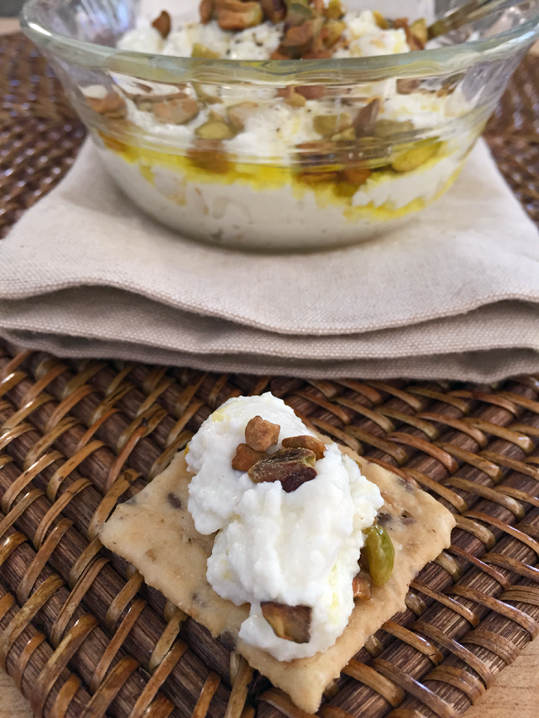Are you a kitchen experimenter or adventurous eater? I don’t mean in the Andrew Zimmern “Bizarre Foods” kind of way (although if stinky tofu or rat hearts are your thing, rock on; I’ll hold off, thanks). No, I’m talking about a willingness to try food combinations or flavors that are just a touch out of your comfort zone. Maybe that means ordering something you wouldn’t usually get from your favorite restaurant, testing out foods in à la Waste-Less Wednesday style, or that WTF moment when you throw some random ingredients together in a pan and see what happens. Thinking differently about ingredients or food combinations or preparation techniques broadens our food options considerably, and the discovery process is just plain fun — especially when you find something you want to share.
Which leads me to an inspiring reader comment about preserved lemons and feta cheese:
I’m just circling back to let you know how we used our preserved lemons. The gremolata was delicious — it fed a whole family very happily. But the biggest discovery was what happened when we combined the lemons with feta. We’ve been buying our feta from Rose International Market on Castro St. in Mountain View for 20+ years….The other day I lightly mixed a wedge of preserved lemon with a little bit of leftover Bulgarian feta and served it with crackers and lavash (also from Rose Market). The resulting spread was just heavenly. I didn’t think it was possible to improve Bulgarian feta, but I guess you never know!
Wheee! Gotta love that! “Two great tastes that taste great together.” And how did this happen? Simply putting some leftovers together for a family dinner. (By the way, thanks for sharing, Monica!) What’s the key here? Starting with ingredients that you enjoy, and saying “what if…?” Sometimes you come up with a winner, sometimes you don’t. If the combination isn’t as delicious and craveable as you’d hoped, shrug it off and try something else. (Not-so-big secret: Most professional chefs don’t nail a new recipe the first time. It’s an ongoing process of testing and tweaking over time.)
After I read Monica’s comment, I started thinking about the combination of salty, sweet-tart preserved lemons with a creamy cheese, soft cheese. Mmmm. I’ve been crushing hard on some Petaluma-made fresh ricotta lately (note to self: stop eating it out of the container). Sheep’s milk ricotta would be a nice, less salty stand-in for the feta — although cow’s milk ricotta would add a buttery richness that could play off the tartness of the lemons. I’ll save you the suspense: both versions are lick-the-bowl good. (And don’t get me wrong, the feta/lemon combo is creamy-sweet-tart mouthbomb, but if you can’t get your hands on creamy Bulgarian or French feta, fresh ricotta is a stellar partner.)
As for the lemons, you can use 7-day or 30-day preserved lemons for this recipe, although the flavors will be a bit different. The 7-day lemons give you a brighter, sweet-tart, lemon flavor, while the 30-day lemons are mellower, but have the added flavor dimension provided by the spices preserved with the lemons. Either way, if you’ve been waiting for a reason to make 7-Day or 30-Day preserved lemons, this is it!
Recipe: Fresh Ricotta and Preserved Lemon Spread
Yield: About 7 ounces
Fresh ricotta is essential here, so try to buy a locally made version — or get adventurous and make your own ricotta at home. Homemade preserved lemons are best, but store-bought will work in a pinch. A good, peppery olive oil and some crunchy, toasted pistachios are the finishing touches to this spread, adding flavor and texture. Serve with crisp crackers, lavash, or on a sturdy piece of toast.
Ingredients
6 ounces fresh ricotta
1½ – 2 wedges preserved lemon, to taste
1 tablespoon toasted pistachio pieces
Olive oil
Salt and freshly ground black pepper, to taste

How to:
- Place the ricotta in a small mixing bowl.
- Finely chop the lemon wedges — skins and flesh — and add them to the ricotta, mixing gently with a spoon or rubber spatula to combine.

Add chopped perserved lemon to the ricotta Start by chopping 1½ wedges and adding those pieces to the ricotta. Give it a taste. If you prefer more lemon, chop the remaining ½ wedge and add it to the mixture. Return any unused lemon pieces or wedges to the storage container.
- Add salt and freshly ground black pepper to taste.
You probably won’t need much salt, as the lemons themselves provide a good amount of salt from the preservation process, but a little accent of a delicate salt, such pyramid or Himalayan pink, can balance the flavor if your mixture is too tart. - Transfer the mixture to a serving bowl, drizzle with olive oil, and top with toasted nuts.

- Store leftovers, covered, in the refrigerator, for up to 5 days.

